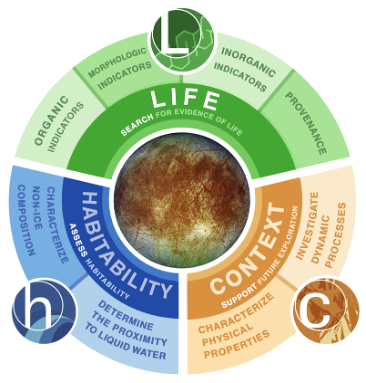The Europa Lander Mission Concept: In Situ Exploration of an Ocean World
- 1NASA Jet Propulsion Laboratory/Caltech, Pasadena, CA United States of America (marissa.e.cameron@jpl.nasa.gov)
- 2Applied Physics Laboratory/Johns Hopkins University, Laurel, MD United States of America
- *A full list of authors appears at the end of the abstract
Introduction: Jupiter’s moon Europa is a prime target in our exploration of potentially habitable worlds beyond Earth, and of ocean worlds in the outer solar system. The exploration of Europa presents an important target for both astrobiology and comparative oceanography, i.e., the opportunity to study liquid water oceans as a planetary process. Europa’s icy shell also offers the opportunity to study tectonics and geologic cycles across a range of mechanisms (e.g., Earth’s cooling versus Europa’s tidal dissipation) and compositions (silicate in the case of the Earth, versus ice in the case of Europa). Europa is a scientifically important and strategic target for both planetary science and astrobiology.
Critically, Europa’s subsurface ocean has likely existed for much of the history of the solar system, potentially providing a persistent, stable environment in which a second, independent origin of life may have arisen. Observations and models indicate that the ocean is likely in contact with a rocky, silicate seafloor, and the ice shell may have tectonic activity that could allow reductant-oxidant cycling. This scenario could lead to an ocean rich in the elements and energy needed for the emergence of life, and for potentially sustaining life through time. The persistence of Europa’s ocean means that life could be alive there today – i.e., signs of extant life could be found within the ice and ocean of Europa. The discovery of signs of extant life is critical if we are to understand biology as a universal process: Does it contain DNA or does it function on some other large biomolecules for information storage, replication, and repair? Are there many separate ‘trees of life’ within our solar system, or is the tree of life on Earth the only one? The search for past life on worlds like Mars is very important, but the search for extant life is how we will truly revolutionize biology (if life exists beyond Earth).

Figure 1. Science goals and objectives of the Europa Lander mission concept. Within each Goal are the high level Objectives, represented as a “fan” across each Goal.
The high-level science goals of the Europa Lander Mission Concept are:
- Search for evidence of biosignatures on Europa.
- Assess the habitability of Europa via in situ techniques uniquely available to a lander.
- Characterize surface and subsurface properties at the scale of the lander to support future exploration.
These goals are achieved by employing a lander on the surface that collects and processes a minimum of three separate samples, each of at least seven cubic centimeter in volume, and acquired from a depth of at least 10 cm.
Overview of Mission Concept: Here we provide an overview of significant milestones, developments, and technology advancements that have been made, or are ongoing, to retire science, technology, cost, and schedule risks associated with the mission concept.
- The mission concept achieves high value science without requiring an excessive number of engineering ‘miracles’; this mission aims to be the right ‘first’ mission to the surface of Europa and balances technical risk with science return and cost.
- The technology and instrumentation investments made to date (which exceed $300M) could enable a new era of planetary exploration. Many of the technologies that have, or are, being developed for the Europa Lander Mission Concept can be utilized for landing on other ocean
- The Europa Lander builds on the investment in Europa Clipper, using data from that mission for landing site There would be at least five years of time between the end of Clipper’s prime mission and the landing site selection date. Importantly, data from Clipper would be unlikely to dramatically change our approach to de-orbit, descent, and landing (DDL). The mission concept team examined a variety of mechanical configurations and concluded that even after the acquisition of the Clipper data, the DDL and mechanical architectures would not significantly change. Uncertainty about parameters such as porosity and structure at the sub-meter scale would still require the intelligent landing system, with terrain relative navigation and hazard avoidance. Furthermore, the lander would still need to employ the ‘snowshoe belly pan’ and ‘grasshopper’ adaptive stabilizer legs to accommodate soft and variable surfaces at the sub-meter scale.
- The Lander concept uses primary batteries and could survive for many weeks to >60 days on the surface, depending on sampling and idle power usage The choice of primary batteries was, in part, to save on cost and complexity. A longer-lived mission concept with a radioisotope power system was studied, but planetary protection, thermal management, and mass were found to contribute to increasing cost and technical risk.
Kevin Hand, Cynthia Phillips, Earl Maize, Glenn Reeves, Jo Eliza Pitesky, Marissa Cameron, Michael Bramble, Shawn Brooks, Morgan Cable, Kate Craft, Ray Crum, Jeffrey Foster, Jason Hofgartner, Amy Hofmann, Kenneth Hurst, Brett Kennedy, Emily Klonicki, Jacob Kosberg, Erin Leonard, Shannon MacKenzie, Chris Paranicas, Divya Persaud, Eric Roberts, Alejandro Miguel San Martin, Jennifer Scully, Lori Shiraishi, Grace Tan-Wang
How to cite: Cameron, M., Hand, K., Phillips, C., Maize, E., Pitesky, J. E., Brooks, S., Craft, K., Crum, R., Hofgartner, J., Hofmann, A., Hurst, K., Kennedy, B., Klonicki, E., Reeves, G., Roberts, E., San Martin, A. M., Scully, J., Shiraishi, L., and Tan-Wang, G. and the Project Science and Engineering Teams: The Europa Lander Mission Concept: In Situ Exploration of an Ocean World, Europlanet Science Congress 2021, online, 13–24 Sep 2021, EPSC2021-386, https://doi.org/10.5194/epsc2021-386, 2021.

